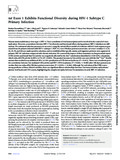| dc.contributor.author | Rossenkhan, Raabya | |
| dc.contributor.author | MacLeod, Iain J. | |
| dc.contributor.author | Sebunya, Theresa K. | |
| dc.contributor.author | Castro-Nallar, Eduardo | |
| dc.contributor.author | McLane, Mary Fran | |
| dc.contributor.author | Musonda, Rosemary | |
| dc.contributor.author | Gashe, Berhanu A. | |
| dc.contributor.author | Novitsky, Vlad | |
| dc.contributor.author | Essex, M. | |
| dc.date.accessioned | 2015-11-26T10:13:55Z | |
| dc.date.available | 2015-11-26T10:13:55Z | |
| dc.date.issued | 2013 | |
| dc.identifier.citation | Rossenkhan, R. et al. (2013) tat exon 1 exhibits functional diversity during HIV-1 subtype C primary infection, Journal of Virology, Vol. 87, No. 10, pp. 5732–5745 | en_US |
| dc.identifier.issn | 0022-538X (print) | |
| dc.identifier.issn | 1098-5514 (online) | |
| dc.identifier.uri | http://hdl.handle.net/10311/1404 | |
| dc.description.abstract | Human immunodeficiency virus type 1 (HIV-1) Tat is a mediator of viral transcription and is involved in the control of virus replication. However, associations between HIV-1 Tat diversity and functional effects during primary HIV-1 infection are still unclear. We estimated selection pressures in tat exon 1 using the mixed-effects model of evolution with 672 viral sequences generated from 20 patients infected with HIV-1 subtype C (HIV-1C) over 500 days postseroconversion. tat exon 1 residues 3, 4, 21, 24, 29, 39, and 68 were under positive selection, and we established that specific amino acid signature patterns were apparent in primary HIV-1C infection compared with chronic infection. We assessed the impact of these mutations on long terminal repeat (LTR) activity and found that Tat activity was negatively affected by the Ala21 substitution identified in 13/20 (65%) of patients, which reduced LTR activity by 88% (±1%) (P < 0.001). The greatest increase in Tat activity was seen with the Gln35/Lys39 double mutant that resulted in an additional 49% (±14%) production of LTR-driven luciferase (P = 0.012). There was a moderate positive correlation between Tat-mediated LTR activity and HIV-1 RNA in plasma (P = 0.026; r = 0.400) after 180 days postseroconversion that was reduced by 500 days postseroconversion (P = 0.043; r = 0.266). Although Tat activation of the LTR is not a strong predictor of these clinical variables, there are significant linear relationships between Tat transactivation and patients' plasma viral loads and CD4 counts, highlighting the complex interplay between Tat mutations in early HIV-1C infection. | en_US |
| dc.language.iso | en | en_US |
| dc.publisher | American Society for Microbiology, http://jvi.asm.org/ | en_US |
| dc.rights | All rights reserved. | en_US |
| dc.subject | Functional diversity | en_US |
| dc.subject | HIV-1 subtype C | en_US |
| dc.subject | HIV-1 infection | en_US |
| dc.subject | HIV-1 tat diversity | en_US |
| dc.subject | Tat exon 1 | en_US |
| dc.subject | Tat activity | en_US |
| dc.title | tat Exon 1 exhibits functional diversity during HIV-1 subtype C primary infection | en_US |
| dc.type | Published Article | en_US |
| dc.rights.holder | Copyright 2013, American Society for Microbiology | en_US |
| dc.link | http://jvi.asm.org/content/87/10/5732.full.pdf+html | en_US |

